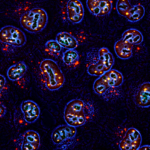Link to Pubmed [PMID] – 17369817
Nat. Cell Biol. 2007 Apr;9(4):428-35
p53 functions to prevent malignant progression, in part by inhibiting proliferation or inducing the death of potential tumour cells. One of the most important regulators of p53 is MDM2, a RING domain E3 ligase that ubiquitinates p53, leading to both proteasomal degradation and relocation of p53 from the nucleus to the cytoplasm. Previous studies have suggested that although polyubiquitination is required for degradation, monoubiquitination of p53 is sufficient for nuclear export. Using a p53-ubiquitin fusion protein we show that ubiquitination contributes to two steps before export: exposure of a carboxy-terminal nuclear export sequence (NES), and dissociation of MDM2. Monoubiquitination can directly promote further modifications of p53 with ubiquitin-like proteins and MDM2 promotes the interaction of the SUMO E3 ligase PIASy with p53, enhancing both sumoylation and nuclear export. Our results suggest that modifications such as sumoylation can regulate the strength of the p53-MDM2 interaction and participate in driving the export of p53.

